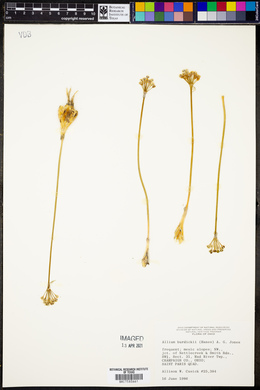Allium burdickii
|
|
|
|
Family: Amaryllidaceae
Narrowleaf Wild Leek, more...Narrowleaf Ramps
[Allium tricoccum var. burdickii Hanes] |
Bulbs 2-6, usually borne on short rhizome, ovoid-conic, 2-4(-5) × 1-1.5 cm; outer coats enclosing 1 or more bulbs, brownish to grayish, reticulate, cells finely fibrous; inner coat white, obscurely cellular, cells irregularly arranged. Leaves ephemeral, usually absent at anthesis, 2-3, basal; leaf blade solid, flat, elliptic to elliptic-lanceolate, (1.5-)2-4(-4.5) cm wide, tapering to long, scarcely petiolate, margins entire, sheaths and petioles not anthocyanous. Scape persistent, solitary, flexuous distally, terete, (10-)13-16(-18) cm × 2-4 mm. Umbel persistent, erect, loose, (6-)12-18(-24)-flowered, obconic, bulbils unknown; spathe bracts persistent, 2, ± 3-veined, lanceolate to lance-ovate, ± equal, apex acute, beakless. Flowers campanulate, 4-7 mm; tepals erect, white to cream or yellowish, oblong to ovate, ± equal, not withering in fruit, margins entire, apex obtuse; stamens ± equaling tepals; anthers white to light yellow; pollen white; ovary crestless; style included, linear, shorter than stamens; stigma capitate, scarcely thickened, unlobed; pedicel 10-20 mm. Seed coat shining; cells smooth. 2n = 16. Flowering early Jun. Dry soil in upland woods; 0--1800 m; Ont., Que.; Ala., Ga., Ill., Ind., Iowa, Ky., Maine, Mich., Minn., Mo., N.H., N.J., N.Y., N.C., N.Dak., Ohio, Pa., S.Dak. Tenn., Vt., Va., W.Va., Wis. Allium burdickii is apparently rare in the eastern part of its range and in the Ozark Plateau region. With its overlapping characteristics and distribution, Allium burdickii is doubtfully separate from A. tricoccum.
Perennial herb with two to six bulbs flowering stem 10 - 20 cm tall Leaves: two or three, basal, nearly stalkless, 19 - 22 cm long, 1 - 2 or more cm wide, flat, lance-shaped to elliptical, dying back before flowering time. Inflorescence: an upright, more or less dome-shaped umbel of six to twenty-five flowers raised on a single narrow stalk and subtended by two, 1 - 2 cm long deciduous bracts. Flowers: white to cream-colored, 4 - 7 mm long, bell-shaped, with six tepals that remain even in fruit. Fruit: a three-lobed capsule. Bulbs: up to 4 cm tall, somewhat oval, and encased in a brownish or gray netlike coating. Similar species: The leaves of Allium burdickii are gone by flowering time, which distinguishes this species from other Allium in the Chicago Region. The similar species, A. tricoccum differs by having longer leafstalks that are reddish and leaves that are wider. Flowering: June to early July Habitat and ecology: Common in woods. Occurence in the Chicago region: native Notes: The name for the city of Chicago is derived from the Native American Miami-Illinois word "chicagoua," which means "striped skunk" and was also used in reference to the smelly wild leek, Allium burdickii or A. tricoccum. The Miami-Illinois commonly named rivers after conspicuous plants in a watershed. "Chicagoua" was their name for the Chicago River. This name was later adopted for the town located at the mouth of the river, Chicago, which was incorporated in 1833. Etymology: Allium comes from the Latin word for garlic. Author: The Morton Arboretum Smaller, the bulb mostly 1-1.5(-2) cm thick, the lvs (1.5-)2-4(-4.5) cm wide, less strongly or scarcely petiolate, the scape arising (10-)13-16(-18) cm, the bracts 1-2 cm, the fls (6-)10-18(-25), the fruiting pedicels 1-2 cm; not anthocyanic; widespread, but chiefly midwestern, extending e. to w. Me., N.J., and the mts. of N.C. and Tenn.; fl early, commonly June. (A. tricoccum var. burdickii) Gleason, Henry A. & Cronquist, Arthur J. 1991. Manual of vascular plants of northeastern United States and adjacent Canada. lxxv + 910 pp. ©The New York Botanical Garden. All rights reserved. Used by permission. From Flora of Indiana (1940) by Charles C. Deam Indiana Coefficient of Conservatism: C = 6 Wetland Indicator Status: FACU Diagnostic Traits: strong-scented pungent herb; base of plants pale; leaves petiolate, flat, 1 cm wide or more, withering before plants flower; inflorescences a scapose simple umbel, larger umbels usually with fewer than 18 flowers. This taxon is often treated as a well-defined variety of A. tricoccum. Allium burdickii has narrower leaves (<2.5 cm wide), pale petioles, leaf sheaths, and stems. Allium tricoccum leaves reach to over 4 cm wide and the plant is reddish at its base. Flowering times also differ: burdickii peaks in June while tricoccum peaks in July. |
|
|
|
































































































